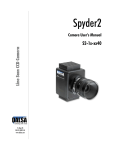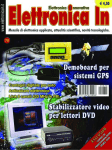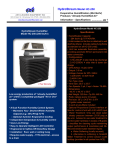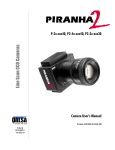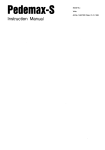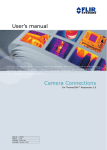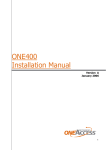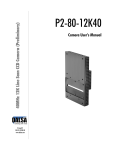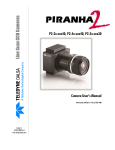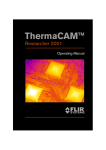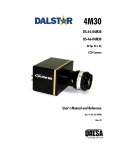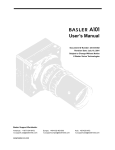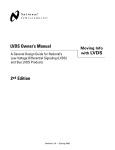Download ECLIPSE - Stemmer Imaging
Transcript
ECLIPSE EC-11-xxx40 Advanced Line Scan Cameras Camera User’s Manual 03-32-00418 rev 05 Printed 4/20/2005 9:26:00 AM EC-11User’s Manual 2 © 2005 DALSA. All information provided in this manual is believed to be accurate and reliable. No responsibility is assumed by DALSA for its use. DALSA reserves the right to make changes to this information without notice. Reproduction of this manual in whole or in part, by any means, is prohibited without prior permission having been obtained from DALSA. About DALSA DALSA is an international high performance semiconductor and electronics company that designs, develops, manufactures, and markets digital imaging products and solutions, in addition to providing wafer foundry services. DALSA’s core competencies are in specialized integrated circuit and electronics technology, and highly engineered semiconductor wafer processing. Products include image sensor components; electronic digital cameras; and semiconductor wafer foundry services for use in MEMS, power semiconductors, image sensors and mixed signal CMOS chips. DALSA is a public company listed on the Toronto Stock Exchange under the symbol “DSA”. Based in Waterloo, ON. Canada, the company has operations in Bromont, PQ; Colorado Springs, CO; Eindhoven, NL; Munich, Germany and Tokyo, Japan. All DALSA products are manufactured using the latest state-of-the-art equipment to ensure product reliability. For further information not included in this manual, or for information on DALSA’s extensive line of image sensing products, please call: DALSA Sales Offices Waterloo Europe Asia Pacific 605 McMurray Rd Waterloo, ON N2V 2E9 Canada Tel: 519 886 6000 Fax: 519 886 8023 www.dalsa.com [email protected] Breslauer Str. 34 D-82194 Gröbenzell (Munich) Germany Tel: +49 - 8142 – 46770 Fax: +49 - 8142 – 467746 www.dalsa.com [email protected] Space G1 Building, 4F 2-40-2 Ikebukuro Toshima-ku, Tokyo 171-0014 Japan +81 3 5960 6353 (phone) +81 3 5960 6354 (fax) www.dalsa.com [email protected] DALSA Worldwide Operations Waterloo Colorado Springs Europe Asia Pacific 605 McMurray Rd Waterloo, ON N2V 2E9 Canada Tel: 519 886 6000 Fax: 519 886 8023 www.dalsa.com [email protected] 4820 Centennial Blvd., Suite 115 Colorado Springs, CO 80919 USA Tel: 719 599 7700 Fax: 719 599 7775 www.dalsa.com [email protected] Breslauer Str. 34 D-82194 Gröbenzell (Munich) Germany Tel: +49 - 8142 – 46770 Fax: +49 - 8142 – 467746 www.dalsa.com [email protected] Space G1 Building, 4F 2-40-2 Ikebukuro Toshima-ku, Tokyo 171-0014 Japan +81 3 5960 6353 (phone) +81 3 5960 6354 (fax) www.dalsa.com [email protected] Camera Link is a trademark registered by the Automated Imaging Association, as chair of a committee of industry members including DALSA. 03-32-00418-05 DALSA Corp. EC-11 User’s Manual 3 Contents Introduction___________________________________________________________ 5 1.1 Camera Highlights.......................................................................................................................................................5 1.2 Image Sensors .............................................................................................................................................................6 1.3 Camera Performance Specifications ............................................................................................................................7 1.4 CCD Camera Primer.....................................................................................................................................................9 Camera Hardware Interface________________________________________________ 11 2.1 Installation Overview...................................................................................................................................................11 2.1 Input/Output................................................................................................................................................................12 2.3 Connectors, Pinouts, and Cables..................................................................................................................................12 2.4 Power Supplies ............................................................................................................................................................13 2.5 Control Inputs ..............................................................................................................................................................13 2.6 Data Bus ......................................................................................................................................................................14 2.7 Timing .........................................................................................................................................................................15 2.8 Multi-Camera Operation .............................................................................................................................................16 2.9 Serial Interface ............................................................................................................................................................17 Optical and Mechanical Considerations ________________________________________ 19 3.1 Mechanical Interface....................................................................................................................................................19 3.2 Optical Interface ..........................................................................................................................................................22 Troubleshooting ________________________________________________________ 25 4.1 Common Solutions.......................................................................................................................................................25 4.2 Troubleshooting Using the Serial Interface.................................................................................................................26 4.3 Specific Solutions .........................................................................................................................................................27 4.4 Product Support...........................................................................................................................................................30 EMC Declaration of Conformity______________________________________________ 35 Software Interface: How to Control the Camera __________________________________ 37 C1 Overview.......................................................................................................................................................................37 C2 Processing Chain...........................................................................................................................................................37 C3 Startup..........................................................................................................................................................................38 C4 Saving and Restoring Settings......................................................................................................................................38 C5 Setting Direction...........................................................................................................................................................39 C6 Setting Line Rate (EXSYNC)..........................................................................................................................................39 C7 Setting Data Rate (EXRCLK).........................................................................................................................................40 DALSA Corp. 03-32-00418-05 4 EC-11User’s Manual C8 Setting Gains ................................................................................................................................................................40 C9 Calibrating the Camera: Overview ...............................................................................................................................41 C10 Increasing Sensitivity with Binning.............................................................................................................................44 C11 Generating Test Patterns............................................................................................................................................44 C12 Returning Video Information .....................................................................................................................................44 C13 Monitoring the Camera ..............................................................................................................................................45 C14 Rebooting the Camera................................................................................................................................................45 C15 Setting the Pre-trigger ...............................................................................................................................................45 C16 Setting and Reading FPN Coefficients........................................................................................................................45 C17 Setting and Reading PRNU Coefficients .....................................................................................................................46 Communications Protocol _________________________________________________ 47 D1 Protocol Overview ........................................................................................................................................................47 D2 Protocol Features .........................................................................................................................................................47 D3 Command Format ........................................................................................................................................................47 D4 Networking Mode.........................................................................................................................................................48 D5 Examples......................................................................................................................................................................48 D6 Error Handling.............................................................................................................................................................48 D7 Commands ...................................................................................................................................................................49 Revision History ________________________________________________________ 53 Index _______________________________________________________________ 55 03-32-00418-05 DALSA Corp. EC-11 User’s Manual 5 1 Introduction 1.1 Camera Highlights Responsivity 2 • 1950 DN/(nJ/cm ) nominal responsivity • 100x more responsive than standard line scan cameras • Ideal for applications with low-intensity, low-cost lighting Size • Small form factor: 50mm x 50mm x 88mm, <350g • C-mount optics for 512 & 1024; F-mount for 2048 Performance • 40MHz single output data rate • 8-bit output from 10-bit digitization • 512, 1024 and 2048 pixels, 13µm x 13µm, 100% fill factor • Line rates up to 64kHz • 96 TDI stages • Bidirectional • RS-644 (LVDS) data format Programmability • Simple ASCII protocol controls binning, gain, offset, line and data rates, trigger mode, direction, pixel correction, test pattern output, and camera diagnostics. • RS-232 interface (ASCII, 9600 baud) Usability • Programmable gains, offsets, and camera controls DALSA Corp. 03-32-00418-05 EC-11User’s Manual 6 • End-of-line sequence and test pattern output for debugging • Single input supply (+12V to +15V) • Compliant with CE and MIL-STD-810E (shock and vibration) • Multiple camera synchronization The EC-11 cameras use DALSA’s newest compact modular architecture. Within the camera, driver circuits provide bias voltages and clocks to the CCD image sensor, timing circuits generate internal timing, and A/D circuits process the video and digitize it for output. Description The EC-11 is an incredibly responsive—100 times greater responsivity than standard line scan cameras, fast—up to 64.1kHz, easy-to-use—programmable pixel-to-pixel correction, line rate, gain and more, and compact—50mm x 50mm x 88mm, <350g., advanced line scan camera. With unmatched sensitivity, performance, size, and an unprecedented array of programmable diagnostic and signal processing features, the EC-11-xxx40 is a truly remarkable camera. The camera’s simple ASCII communications protocol allows you to configure and program virtually all camera functions through an RS232 serial interface. To speed setup and system debugging, the camera can output a test pattern and end-ofline sequence to help track the path of data through an acquisition system. Applications The EC-11 is ideal for space-constrained applications demanding low-light or costeffective lighting. 1.2 Image Sensors The EC-11-xxx40 uses the IT-F7 family of image sensors, and is available in 512, 1024 and 2048 pixel models with 13µm square pixels and 100% fill factor. 03-32-00418-05 DALSA Corp. EC-11 User’s Manual 7 Figure 1: IT-F7 Image Sensor CR1S-1R CRLast-R CR2B-2R I CR1B-2R CR2S-1R CR2B-1R OS1R Reverse CCD Readout Shift Register I TDI Imaging Region 13µm x 13µm Pixels 96 TDI Rows CI1 CI2 CI3 CI4 4I 4S TDI Col. 2 4S 4I TDI Col. 1 TCKF TDI Col. N-1 TDI Col. N 1.25 Isolation Rows TCKR 1.5 Isolation Rows I VBB CR1B-1R Forward CCD Readout Shift Register CR2S-1F CR1S-1F CRLast-F I CR2B-2F CR1B-2F CR1B-1F CR2B-1F 4S 4 Light Shielded Columns (Dark Reference) 4 I 4 Isolation Columns (2.5 light shielded +1.5 non-shielded) I 9 Dummy Pixels & 1 White Reference N = 512, 1024 or 2048 1.3 Camera Performance Specifications Table 1: EC-11-xxx40 Performance Specifications Physical Characteristics Units Power Dissipation W Typ 512 5 1024 5.2 2048 5.4 Time to calibrate sec. Typ 512 10 1024 17 2048 30 Time to power up, typ Forward/Reverse Switching Time, typ sec. ms >10 150 Sensor Alignment mm mm mm “ µm ±0.18 17.52 ±0.18 46.50 ±0.18 ±0.6 <100 Operating Ranges Units Min Max Notes Data Rate MHz 10 40 3 512 kHz 3.5 64.1 1024 kHz 3.5 34.8 2048 kHz 3.5 17.4 x, y z-axis Θz Parallelism/Tilt Line Rate DALSA Corp. Notes C-mount F-mount 03-32-00418-05 EC-11User’s Manual 8 Operating Ranges Units Min Max Temperature °C 0 50 Temperature drift before recalibration, recommendation °C RS232 Data Rate kbps Photoresponse Variation across field of view (combining light source variation and lens vignetting) DN Electro-Optic Specifications Units Average Broadband Responsivity, typ DN/(nJ/cm2 ) Dynamic Range Ratio Notes 10 9.6 (onl y) 128 (7 bits) 2 Min Typ Max 730 1950 5850 Notes 1 Minimum Gain 272: 1 500:1 0dB Gain 174: 1 350:1 Maximum Gain 63:1 120:1 Pk-Pk Noise, max DN 4 8 24 1 RMS Noise, max DN 0.9 1.4 3.8 1 FPN uncorrected, max DN 6 15 46 1 FPN corrected, max DN 2 4 10 1,4 PRNU uncorrected, max DN 14 23 54 1 PRNU corrected, max DN 4 6 12 1,4 DC Offset, max DN 3 5 7 1,5 Power Supply Current - Vin @ 12V mA 1 512 420 480 1024 430 500 2048 450 540 Notes: DN = Digital Numbers (0-255); also known as gray levels. 1. Min, Typ, and Max are maximum values at the minimum, 0dB, and maximum gain levels. Tungsten halogen light source, 3200K bulb temp., and 750nm cutoff filter. 2. This specification represents the amount of variance across the field of view that the camera can compensate for with its FPN and PRNU correction algorithms. 3. Internal clock: Camera is selectable between 40, 20 and 10MHz data rates. External clock (EXRCLK): Range between 10-40MHz. 4. This is the value the specification can meet when the camera is calibrated and remains at the calibrated temperature. It is recommended that after a >10°C temperature change the camera is re-calibrated because DC Offset, FPN and PRNU vary with temperature. 03-32-00418-05 DALSA Corp. EC-11 User’s Manual 9 5. DC Offset needs to be set at calibrated gain setting. Digital gain correction may be required to achieve maximum values. Figure 2: EC-11 Spectral Responsivity EC-11 Typical Spectral Responsivity Responsivity DN/(nJ/cm²) 2500 2000 1500 1000 500 0 450 550 650 750 850 950 1050 Wavelength (nm) 1.4 CCD Camera Primer How CCD Image Sensors Work A CCD image sensor converts photons (light) into electrons (charge). When photons hit an image sensor, the sensor accumulates electrons. This is called charge integration. The brighter your light source, the more photons available for the sensor to integrate, and the smaller the amount of time required to collect a given amount of light energy. The way photosensitive elements (pixels) on CCD image sensors collect charge has often been compared to wells or buckets filling with water. From this analogy comes the term "full-well capacity," meaning the maximum charge (number of electrons) a pixel well can hold without "spilling" charge onto adjacent pixels. As an image sweeps over a line of pixels, the pixels collect charge. At certain intervals, the sensor transfers its collected charge to one or more readout registers, which feed each pixel’s charge from the image sensor into an output node that converts the charges into voltages. DALSA Corp. 03-32-00418-05 10 EC-11User’s Manual After this transfer and conversion, the voltages are amplified to become the camera’s analog output. In digital output cameras, the camera’s analog-todigital (A/D) board converts voltages to digital numbers (0255 for 8-bit cameras, 0-4095 for 12-bit cameras). These digital numbers are what the camera outputs as data to a frame grabber. For more information on terms and concepts from the digital imaging industry, see DALSA’s current Databook Glossary, CCD Technology Primer, and Application Notes. 03-32-00418-05 DALSA Corp. EC-11 User’s Manual 11 2 Camera Hardware Interface 2.1 Installation Overview In order to set up your camera, you should take these steps: 1. Data 2. STROBE 3. LVAL 4. R232 port 5. Power connect You must also set up the other components of your system, including light sources, frame grabbers, camera mounts, heat sinks, host computers, optics, encoders, and so on. 8 B IT D ata ST R O B E E X S Y N C (o ptio n al) E X R C L K (o p tio na l) F O RW A R D (o p tio n al) R S 23 2 Se r ial DALSA Corp. + 12 V to + 1 5V an d G ro un d 03-32-00418-05 EC-11User’s Manual 12 2.1 Input/Output ! WARNING: It is extremely important that you apply the appropriate voltages to your camera. Incorrect voltages will damage the camera. See section 2.4 for more details. 2.3 Connectors, Pinouts, and Cables The camera uses a high-density 36-pin MDR36 connector for control, and data signals, a 6-pin Hirose connector for power, and a DB9 connector for serial communications. M D R 3 6 Fem ale 18 1 36 19 H irose 6-pin C ircular M ale 6 1 5 2 4 3 03-32-00418-05 Description N /U N /U F utu re U se F utu re U se E X R C LK F O RW A R D EXSYN C F utu re U se D7 D6 D5 D4 D3 D2 D1 D0 ST RO B E LVA L Pin 19 20 21 22 23 24 25 26 27 28 29 30 31 32 33 34 35 36 Description N /U N /U F utu re U se F utu re U se E X R C LK B F O RW A R D B EXSYN C B F utu re U se D 7B D 6B D 5B D 4B D 3B D 2B D 1B D 0B ST RO B E B LVA L B 5 Pin 1 2 3 4 5 6 Description + 1 2V to + 1 5 V + 1 2V to + 1 5 V + 1 2V to + 1 5 V GND GND GND 1 6 9 "straight-through" 9-pin serial cable M ating Part: H IRO SE H R 10A -7P-6S M ating Part: 3M 10136-6000EC series C able: 26AW G 100 W shielded tw isted pair Pin 1 2 3 4 5 6 7 8 9 10 11 12 13 14 15 16 17 18 D B 9 Fem ale Pin 1 2 3 4 5 6 7 8 9 Description D ata C arrier D etect, N /U Tran sm itted D ata R eceived D ata D ata Term in al R ead y, N /U GND D ata Set R eady, N /U R ead y To Sen d , N /U C lear To Send , N /U R in g In d icato r, N /U DALSA Corp. EC-11 User’s Manual 13 2.4 Power Supplies The camera requires a single input (+12V to +15V). The camera meets all performance specifications using standard switching power supplies, although well-regulated linear supplies provide optimum performance. See the Performance Specifications for current requirements. When setting up the camera’s power supplies follow these guidelines: • Protect the camera with a fast-blow fuse between power supply and camera. • Do not use the shield on a multi-conductor cable for ground. • Keep leads as short as possible to reduce voltage drop. See section 1.3 for power requirements. ! WARNING: It is extremely important that you apply the appropriate voltages to your camera. Incorrect voltages will damage the camera. Protect the camera with a fast-blow fuse between power supply and camera. The companies listed below make power supplies that meet the camera’s requirements, but they should not be considered the only choices. Many high quality supplies are available from other vendors. DALSA assumes no responsibility for the use of these supplies. • Uniforce, 408-946-3864 (CA, USA) • Power-One, 805-987-8741 (CA, USA) • Vision 1, 406-585-7225 (MT, USA) • Tectrol Inc., 416-630-4026 (ON, CAN) • Xantrex, 206-671-2966 (WA, USA) 2.5 Control Inputs The camera accepts control inputs through an MDR36F connector. All inputs are optional. The camera ships in default, logic HIGH. The camera defaults (no external input required) to maximum data rate, forward direction, maximum line rate, and internal sync to trigger readout. Line rate can be set internally using the RS232 interface. External control signals, EXSYNC, EXRCLK, and FORWARD, are optional and enabled through the RS232 interface. Control signals use EIA-644 (LVDS) format, which requires twisted pair cable. DALSA recommends shielded cables. Maximum cable length depends on environmental factors and EIA-644 limitations. See Appendix A. Control signals are differential, requiring complements denoted with a “B” suffix (e.g. BIN, BINB). DALSA Corp. 03-32-00418-05 EC-11User’s Manual 14 EXRCLK EXRCLK is an optional input signal used to control readout timing. EXRCLK is applied to the read portion of a FIFO and directly drives STROBE and LVAL. EXRCLK is required for multisync operations. EXSYNC (Triggers Line Readout) EXSYNC is an optional input signal that can be used to trigger the line readout rate. This camera uses the falling edge of EXSYNC to trigger line readout. Note: EXSYNC must not be clocked faster than the camera’s specified maximum line rate. IMPORTANT: This camera uses the falling edge of EXSYNC to trigger line readout, unlike previous DALSA cameras, which used the rising edge. Notes on Free Run Mode When the camera is powered on for the first time, it defaults (no external input required) to free run mode (maximum data rate, forward direction, maximum line rate, and internal Sync to trigger readout). Subsequently it will load user settings. FORWARD FORWARD is an optional input signal supporting bidirectional camera functionality. “Logic high” for forward direction. “Logic low” for reverse. Eclipse defaults to “logic high”, forward. 2.6 Data Bus See section 2.3 for pinouts. These signals indicate when data is valid, allowing you to clock the data from the camera to your acquisition system: Clocking Signal Indicates LVAL (high) STROBE (rising edge) Outputting valid line Valid data IMPORTANT: This camera’s data should be sampled on the rising edge of STROBE. Digital Data The camera digitizes to 10-bit ADCs and outputs the most significant 8 bits in LVDS format. To clock digital data into a frame grabber, the camera outputs clocking signals STROBE and LVAL. The camera digitizes internally to 10 bits and outputs the most significant 8 bits in LVDS format on a MDR36F connector. Test Pattern Pixels and End-of-line Sequence To facilitate system-level debugging and verification of data path integrity, the camera can generate both a test pattern and an end-of-line sequence. 03-32-00418-05 DALSA Corp. EC-11 User’s Manual 15 The test pattern is a ramp from 0 to 255DN, then starts at 0 again. Use the test pattern to verify the proper timing and connections between the camera and the frame grabber. The end-of-line sequence outputs “aa”, “55”, “line counter”, “line average”, “pixels above threshold”, “pixels below threshold”. 2.7 Timing Figure 3. EC-11-xxx40 Timing LVAL T LVAL T STROBE STROBE T DATA Data Table 2: Timing Definition Symbol Parameter Unit Min. Nom. Max. TLVAL Strobe to LVAL ns 12 15 18 TDATA Strobe to Data ns 5 10 20 TSTROBE Strobe period ns 25 25 100 Notes: • TLVAL and TDATA measured at 40MHz. DALSA Corp. 03-32-00418-05 EC-11User’s Manual 16 2.8 Multi-Camera Operation Multisync is used to connect two or more cameras to the frame grabber and receive all of the camera’s output synchronously. The camera switches to multisync mode when both EXSYNC and EXRCLK are applied. You may need to compensate for cable lengths and nominal delays. Multi-Camera Sync If your frame grabber is capable of receiving 16 or more bits, you can connect two or more cameras to the frame grabber and receive all of the cameras’ output synchronously to image a wider web. However, since most frame grabbers accept only one set of clocking signals, you must synchronize the outputs by configuring your system to meet these requirements: 1. All cameras must receive identical, synchronous EXRCLK and EXSYNC signals (max. external EXRCLK = 40 MHz. EXRCLK:Pixel Clock ratio is 1:1). Compensate for different cable lengths and nominal delays. 2. The timing relationship between the rising edge of EXSYNC and the rising edge of MCLK must meet the requirements in the diagram below: EXSYNC Thold Tsetup Thold min 2ns EXRCLK Tsetup min 6ns 3. Data and control cabling must be separate for each camera. Although each camera will get the same EXRCLK and EXSYNC signals, the control signals must come from separate differential pairs of a LVDS line driver. Because the cameras’ output will be synchronized, use the data clocking signals (LVAL, STROBE) from just one of the cameras to clock all the others. 03-32-00418-05 DALSA Corp. EC-11 User’s Manual 17 2.9 Serial Interface Camera features can be controlled through the serial interface (RS232, 9600 baud). The serial interface uses simple ASCII-based protocol and the camera does not require any custom software. The complete protocol is described later in the manual (Appendix C and D). Functions available include: • Controlling basic camera functions such as binning (horizontal and vertical), gain, offset, line and data rate, and direction • Pixel-by-pixel FPN and PRNU correction and balancing • Measuring sensor temperature, supply voltages • Capturing video and line statistics • Generating end-of-line sequencing (line counter, line average, pixels above/below threshold) and test patterns for debugging For quick help, the camera can return all available commands and parameters through the serial interface. DALSA Corp. 03-32-00418-05 18 03-32-00418-05 EC-11User’s Manual DALSA Corp. EC-11 User’s Manual 19 3 Optical and Mechanical Considerations 3.1 Mechanical Interface The camera’s electronics are housed in a ruggedized lightweight aluminum case. See Figure 4. Mounting The camera can be mounted using the M3 holes (metric-threaded) on its base or top. ! IMPORTANT: The mounting of the camera is critical. Improper mounting may affect alignment. All sensor measurements are based on alignment with the front plate of the camera. Refer to Figure 3. Mechanical Interface. Environment The camera and cables should be shielded from environmental noise sources for best operation. The camera should also be kept as cool as possible. Specified operating temperature is 0-50° C. Mounting holes (see above) allow you to attach heat sinking. Periscope Configuration To give users more mechanical flexibility, this camera is available in a periscope configuration that reduces the z-axis space required to mount the camera, allowing you to regain up to several inches of working space by channeling the camera body and cabling perpendicular to the optical axis. DALSA Corp. 03-32-00418-05 EC-11User’s Manual 20 Figure 4. Mechanical Interface 512, 1024 Relative position of pixel 1 (forward) 25 ±0.18mm 25 ±0.18mm 2048 8.1 2048 Lens Mount Detail 12.1 14.5 15.5 Relative position of pixel 1 (forward) 03-32-00418-05 DALSA Corp. EC-11 User’s Manual 21 “Periscope” Configuration 512, 1024 Relative position of pixel 1 25 ±0.18mm 137 (2x) 25 ±0.18mm 32 (2x) M3.0 – 0.5 7 DEEP TYP 148 143 32 35 81 (2x) 25 22 (2x) 50 55 32 (2x) 2048 137 32 M3x0.5 TYP 7 DEEP 25 ±0.18mm 50 148 143 81 25 ±0.18mm 33 32 32 22 64 Relative position of pixel 1 DALSA Corp. 03-32-00418-05 EC-11User’s Manual 22 3.2 Optical Interface The cameras come with a built in C-mount lens adapter for the 512 and 1024 models. A built in F-mount adapter is provided on the 2048 model. Both adapters have the appropriate back focal distance for the lens types being used. Ensure that the image circle diameter of the lens to be used is as great as the length of the imaging region of the image sensor. Illumination The amount and wavelengths of light required to capture useful images depend on the particular application. Factors include the nature, speed, and spectral characteristics of objects being imaged, exposure times, light source characteristics, environmental and acquisition system specifics, and more. DALSA’s current Databook provides an introduction to this potentially complicated issue. See “Radiometry and Photo Responsivity” and "Sensitivities in Photometric Units" in the CCD Technology Primer chapter. It is often more important to consider exposure than illumination. The total amount of energy (which is related to the total number of photons reaching the sensor) is more 2 important than the rate at which it arrives. For example, 5µJ/cm can be achieved by 2 2 exposing 5mW/cm for 1ms just the same as exposing an intensity of 5W/cm for 1µs. Light Sources Keep these guidelines in mind when setting up your light source. • LED light sources are relatively inexpensive, provide a uniform field, and longer lifespan compared to other light sources. However, they also require a camera with excellent sensitivity, such as DALSA’s Eclipse camera. • Halogen light sources generally provide very little blue relative to IR. • Fiber-optic light distribution systems generally transmit very little blue relative to IR. • Some light sources age; over their lifespan they produce less light. This aging may not be uniform—a light source may produce progressively less light in some areas of the spectrum but not others. Filters CCD cameras are extremely responsive to infrared (IR) wavelengths of light. To prevent infrared from distorting the images you scan, use a “hot mirror” or IR cutoff filter that transmits visible wavelengths but does not transmit wavelengths over 750nm. Examples are the Schneider Optics™ B+W 489, which includes a mounting ring, the CORION™ LS750, which does not include a mounting ring, and the CORION™ HR-750 series hot mirror. Lens Modeling Any lens surrounded by air can be modeled for camera purposes using three primary points: the first and second principal points and the second focal point. The primary 03-32-00418-05 DALSA Corp. EC-11 User’s Manual 23 points for a lens should be available from the lens data sheet or from the lens manufacturer. Primed quantities denote characteristics of the image side of the lens. That is, h is the object height and h′ is the image height. The focal point is the point at which the image of an infinitely distant object is brought to focus. The effective focal length (f′) is the distance from the second principal point to the second focal point. The back focal length (BFL) is the distance from the image side of the lens surface to the second focal point. The object distance (OD) is the distance from the first principal point to the object. Figure 5. Primary Points in a Lens System Magnification and Resolution The magnification of a lens is the ratio of the image size to the object size: m= h′ h where m is the magnification, h’ is the image height (pixel size) and h is the object height (desired object resolution size). By similar triangles, the magnification is alternatively given by: m= f′ OD These equations can be combined to give their most useful form: h′ f′ = h OD This is the governing equation for many object and image plane parameters. Example: An acquisition system has a 512 x 512 element, 10µm pixel pitch area scan camera, a lens with an effective focal length of 45mm, and requires that 100µm in the object space correspond to each pixel in the image sensor. Using the preceding equation, the object distance must be 450mm (0.450m). 10µm 45mm = 100µm OD DALSA Corp. OD = 450mm (0.450m) 03-32-00418-05 24 03-32-00418-05 EC-11User’s Manual DALSA Corp. EC-11 User’s Manual 25 4 Troubleshooting The information in this chapter can help you solve problems that may occur during the setup of your camera. Remember that the camera is part of the entire acquisition system. You may have to troubleshoot any or all of the following: • power supplies • cabling • frame grabber hardware & software • host computer • light sources • optics • operating environment • encoder Your steps in dealing with a technical problem should be: 1. Try the general and specific solutions listed in sections 4.1, 4.2 and 4.3. 2. If these solutions do not resolve your problem, see section 4.4 on getting product support. 4.1 Common Solutions Connections The first step in troubleshooting is to verify that your camera has all the correct connections. Power Supply Voltages Check for the presence of all voltages at the camera power connector. Verify that all grounds are connected. EXSYNC When the camera is powered on for the first time, it defaults (no external input required) to free run mode (maximum data rate, forward direction, maximum line rate, and internal Sync to trigger readout). After a user has saved settings, the camera power ups with the saved settings. Note, a warning appears when switching to external signals (EXSYNC or EXRCLK) with no preset signals. DALSA Corp. 03-32-00418-05 EC-11User’s Manual 26 EXRCLK EXRCLK is an optional input signal used to control readout timing. EXRCLK is applied to the read portion of a FIFO and directly drives STROBE and LVAL. Data Clocking/Output Signals Verify the presence of all data clocking and output signals. Trigger the oscilloscope from the rising edge of LVAL (ch1; DC coupled). Adjust the oscilloscope time base to allow for a complete cycle of each signal: • STROBE—Verify the presence of the STROBE and STROBEB signals. There should be a continuous clock signal present at the same frequency as your data rate. Sample data on the rising edge of STROBE. • LVAL—Verify the presence of the LVAL and LVALB signals. • Digital Output—Do not probe LVDS data signals with a scope probe unless it has less than 0.5pf of capacitance. If you can probe safely, use LVAL to trigger the scope sweep. Illuminate the camera target and check each individual digital output signal on ch2 of the oscilloscope (±D0 - D7 on the digital output connector). The digital output data signal should change value when light is blocked from the camera lens. Ensure that the bitpattern, that is output just before the active video pixels, is correct (as specified in Chapter 2). If any of the above signals are missing, contact DALSA product support. 4.2 Troubleshooting Using the Serial Interface The following commands can aid in debugging. (The complete command protocol is described in Appendix C and D.) Verify Parameters To verify the camera setup, send the get_camera_parameters command. Verify Factory Calibrated Settings To restore the camera’s factory settings and reset the FPN and PRNU coefficients to 0, send the restore_factory_settings command. After executing this command send the get_camera_parameters command to verify the factory settings. Verify Timing and Digital Video Path To generate a test pattern, use the command set_video_mode 2. The test pattern is a ramp from 0 to 255DN, then starts at 0 again. Use the test pattern to verify the proper timing and connections between the camera and the frame grabber and verify the proper output along the digital processing chain. 03-32-00418-05 DALSA Corp. EC-11 User’s Manual 27 • No test pattern or bad test pattern — May indicate a problem with the camera (e.g. missing bit) or a system setup problem (e.g. frame grabber or timing). Verify the presence of the LVAL and STROBE signals. • Test pattern successful — Run the set_video_mode 0 command to deactivate video correction. Then run the get_line command under both dark and light conditions to retrieve a line of raw video (no digital processing). Under dark conditions, with factory settings, the analog offset value should be within the specified range (refer to the user specifications). Adjust the analog offset using the set_analog_offset and calibrate_analog_offset commands. Under light conditions, you should receive a value. Verify Voltage To check the camera’s input voltages and internal voltages, use the verify_voltage command. If they are within the proper range, the camera returns OK>. Otherwise the camera returns an error message. Verify Temperature To check the internal temperature of the camera, use the verify_temperature command. For proper operation, this value should not exceed 75°C. Verify Pixel Coefficients To activate video correction, send the command set_video_mode 1. Then use the display_pixel_coeffs command to display the pixel coefficients in the order PRNU, FPN, PRNU, FPN, …for both directions. 4.3 Specific Solutions No Output or Erratic Behavior If your camera provides no output or behaves erratically, it may be picking up random noise from long cables acting as antennae. Do not attach wires to unused pins. Verify that the camera is not receiving spurious inputs (e.g. EXSYNC or EXCLK, if camera is in external mode). Line Dropout, Bright Lines, or Incorrect Line Rate Verify that the frequency of the internal sync is set correctly, or when the camera is set to external sync that the EXSYNC signal supplied to the camera does not exceed the camera’s maximum specified line rate. Noisy Output Check your power supply voltage outputs for noise. Noise present on these lines can result in poor video quality. Low quality or non-twisted pair cable can also add noise to the video output. DALSA Corp. 03-32-00418-05 EC-11User’s Manual 28 Dark Patches If dark patches appear in your output the optics path may have become contaminated. Clean your lenses and sensor windows with extreme care. 1. Take standard ESD precautions. 2. Wear latex gloves or finger cots 3. Blow off dust using a filtered blow bottle or dry, filtered compressed air. 4. Fold a piece of optical lens cleaning tissue (approx. 3" x 5") to make a square pad that is approximately one finger-width 5. Moisten the pad on one edge with 2-3 drops of clean solvent—either alcohol or acetone. Do not saturate the entire pad with solvent. 6. Wipe across the length of the window in one direction with the moistened end first, followed by the rest of the pad. The dry part of the pad should follow the moistened end. The goal is to prevent solvent from evaporating from the window surface, as this will end up leaving residue and streaking behind. 7. Repeat steps 2-4 using a clean tissue until the entire window has been cleaned. 8. Blow off any adhering fibers or particles using dry, filtered compressed air. Stuck Bits If data bits seem to be stuck or do not change, check that the camera is not saturated by preventing light from entering. To verify the data path integrity, check the levels of the 2 test pattern pixels (first 2 pixels following the last End-of-line pixel. You may need to turn the End-of-line sequence “on” by sending the command endof_line_sequence 1). Any deviation from a consistent value of these pixels (170DN/85DN) could be an indication of the following: • shorted bits • stuck bits • digital noise pickup on the I/O cable • open connection. To activate the test pattern, use the command set_video_mode 2. Use the test pattern to verify the proper timing and connections between the camera and frame grabber. To receive a complete line of raw video data (without digital processing or test pattern) through the RS232 port, use the command get_line. The returned data displays one pixel value after another and the minimum, maximum, and mean value of the sampled line. Use this command to ensure the proper video input range. Probe the output lines with an oscilloscope. Disconnect the digital cable from the camera and check the digital signals at the output of the camera. Ensure that the correct values are present. Check all cable connections, especially right at the connector; poor connections or broken wires will cause randomly changing bits or stuck bits. 03-32-00418-05 DALSA Corp. EC-11 User’s Manual 29 Horizontal Lines or Patterns in Image A faulty or irregular encoder signal may result in horizontal lines due to exposure time fluctuations; ensure that your exposure time is regular. If you have verified that your exposure time is consistent and patterns of low frequency intensity variations still occur, ensure that you are using a DC or high frequency light source. DALSA Corp. 03-32-00418-05 EC-11User’s Manual 30 4.4 Product Support If the troubleshooting flowchart indicates a problem with your camera, collect the following data about your application and situation and call your DALSA representative. Note: You may also want to photocopy this page to fax to DALSA. Customer name Organization name Customer phone number fax number Complete Product Model Number (e.g. EC-11-xxx40...) Complete Serial Number Your DALSA Agent or Dealer Acquisition System hardware (frame grabber, host computer, light sources, etc.) Acquisition System software (version, OS, etc.) Power supplies and current draw Data rate used Control signals used in your application, and their frequency or state (if applicable) Detailed description of problem encountered. EXSYNC MCLK PRIN BIN Other _______ please attach description with as much detail as appropriate In addition to your local DALSA representative, you may need to call DALSA Technical Sales Support: Voice: Fax: 03-32-00418-05 North America 519-886-6000 519-886-8023 Europe +49-8142-46770 +49-8142-467746 Asia 519-886-6000 519-886-8023 DALSA Corp. EC-11 User’s Manual 31 APPENDIX A: EIA-644 Reference EIA-644 is an electrical specification for the transmission of digital data. The standard is available from the EIA (Electronic Industries Association). It defines voltage levels, expected transmission speeds over various cable lengths, common mode voltage operating requirements for transmitters and receivers, and input impedances and sensitivities for receivers. The table below gives a quick comparison between EIA-644 and RS422 (another differential standard). Table 3: RS422 vs. EIA-644 Parameter Differential Driver Output Voltage Receiver Input Threshold Data Rate Supply Current, Quad Driver (no load, static)* Prop. Delay of Driver, max.* Prop. Delay of Receiver, max.* Supply Current, Quad Receiver (no load, static)* RS422 EIA-644 ±2-5V ±200mV <30Mbps 60mA 11ns 30ns 23mA ±250-450mV ±100mV >400Mbps 3.0mA 3ns 5ns 10mA * based on National Semiconductor DS90C031/2 The standard requires that two wires (e.g. twisted pair) be used to transmit one signal in a differential mode. This means that one wire will be logic HIGH while the other wire is logic LOW. Voltage swing between HIGH and LOW is approximately 350mV, with a typical offset of approximately 1.25V. The use of differential signal transmission allows the receiver to reject common mode voltages. This noise rejection improves data integrity and allows cameras to be installed in an industrial environment. EIA-644-compatible line receivers and drivers are available from many different IC manufacturers in a variety of fabrication technologies such as CMOS and GaAs. The EIA644 standard does not define specific voltages, so it can migrate from 5V power supplies to 3.3V and sub-3V. DALSA recommends the use of 5V CMOS line drivers and receivers such as National Semiconductor parts DS90C031 quad line driver and DS90C032 quad line receiver. To achieve full benefit of the common mode rejection, twisted pair cable should be used for all EIA-644 signals. The cable impedance should be 100 Ohms and the cable terminated at the receiving end with a 100 Ohm resistor. All EIA-644 inputs in a DALSA camera are terminated with 100 Ohms between the (+) and (-) of a signal. Figure A-1 (a) shows an example of an EIA-644 transmission. DALSA indicates the (+) signal by the name of the signal; i.e. EXSYNC, while the (-) signal is indicated by either an overscore over the name or appending the letter B to the end of the name; i.e. EXSYNC or EXSYNCB. The (+) signal has the same sense as the TTL signal which is sent or received; i.e. when EXSYNC in the TTL domain is HIGH then EXSYNC in the EIA-644 domain is HIGH. The (-) signal has the opposite sense of the TTL domain signal and so if EXSYNC TTL is HIGH then EXSYNCB EIA-644 is LOW. Figure 6 shows the relationship. DALSA Corp. 03-32-00418-05 EC-11User’s Manual 32 Figure 6. EIA-644 Example Unused EIA-644 Inputs and Outputs Unused outputs should be left unconnected. This will reduce power dissipation within the camera and reduce radiated emissions. Unused inputs should also be left unconnected; EIA-644 chips have fail-safe features that guarantee a known logic state (HIGH) in fault conditions (unconnected, shorted, or unterminated). Do not connect cables to unused inputs. Cables can act as antennae and cause erratic camera behavior. Cable Lengths Figure 7 shows a graph of ideal communication data rate vs. cable length for the EIA-644 standard. 03-32-00418-05 DALSA Corp. EC-11 User’s Manual 33 Figure 7. EIA-644 Data Rate vs. Cable Length 1000 Data Rate (Mbps) 20% Jitter Measured at 0V Differential 20% Jitter Measured at ±0100mV Differential 100 CAT3 Cable Typical Data Rate vs. Cable Length (National DS90C031) 10 1 1 2 3 5 10 Cable Length (m) DALSA Corp. 03-32-00418-05 34 03-32-00418-05 EC-11User’s Manual DALSA Corp. EC-11 User’s Manual 35 APPENDIX B: EMC Declaration of Conformity We, DALSA Corp. 605 McMurray Rd., Waterloo, ON CANADA N2V 2E9 declare under sole responsibility, that the product(s): EC-11-xxx40 fulfill(s) the requirements of the standard(s) EMC: FCC Part 15 ICES-003 EN 55022: 1998 EN 55024: 1998 EN 61000-6-1: 2001 This product complies with the requirements of the Low Voltage Directive 73/23/EEC and the EMC Directive 89/336/EEC and carries the CE mark accordingly. Place of Issue Waterloo, ON, CANADA Date of Issue 08 March 2005 Name and Signature of authorized person Hank Helmond Quality Manager, DALSA Corp. This Declaration corresponds to EN 45 014. DALSA Corp. 03-32-00418-05 36 03-32-00418-05 EC-11User’s Manual DALSA Corp. EC-11 User’s Manual 37 APPENDIX C: Software Interface: How to Control the Camera C1 Overview i See the Communications Protocol for the complete syntax and command reference (including command shortcuts) for the camera’s serial interface. All Eclipse camera features can be controlled through the serial interface. The camera can also be used without the serial interface after it has been set up correctly. Functions available include: • Controlling basic camera functions such as gain and sync signal source • Camera calibration • Measuring temperature and supply voltages • Capturing video • Generating a test pattern for debugging The serial interface uses a simple ASCII-based protocol and the camera does not require any custom software. The complete protocol is described in the Communications Protocol. For quick help, the camera can return all available commands and parameters through the serial interface. To generate this list, send the command help to the camera. Serial Protocol Defaults • 8 data bits • 1 stop bit • No parity • No flow control • 9.6Kbps • Camera does not echo characters C2 Processing Chain The figure below is a simplified block diagram of the camera's processing chain. The analog processing chain contains two elements–a gain stage and an offset stage. The digital processing chain contains the FPN correction, PRNU correction, background subtract, and a system gain stage. The command set, detailed in the Communications Protocol, allows the user to set and change all the elements of the processing chain separately for the forward and reverse direction. This enables maximum processing flexibility and optimized forward/reverse matching depending on the user requirements. DALSA Corp. 03-32-00418-05 EC-11User’s Manual 38 In addition, the two elements of the analog processing chain can be adjusted separately in calibrated and uncalibrated mode. When changing analog processing values between the two video mode settings, the camera automatically adjusts the settings according to the video mode as well as the direction the camera is operating in. D igital Processing C3 Startup When the camera is first started, it must perform several actions before it is ready for imaging. This startup routine takes approximately 10 seconds, and follows this sequence: 1. Initializes the camera and all internal hardware. 2. Loads the last settings saved to non-volatile memory, including the last set of video correction coefficients, if previously saved. 3. Restores user settings if previously saved, otherwise factory settings. 4. Performs a memory test and voltage test and reports an error if any occurred. After this startup sequence is complete, the camera will return either the prompt "OK>" if no error occurred, or an error code if a problem has been discovered. C4 Saving and Restoring Settings i All commands have short forms. See the Communications Protocol for the complete syntax and command reference. 03-32-00418-05 The camera provides a number of commands for restoring, storing, and saving settings. To restore the original factory settings, use the command restore_factory_settings. The FPN and PRNU coefficients are reset to 0. To save all current user settings to EEROM, use the command write_user_settings. The camera will automatically restore the saved user settings when powered up. DALSA Corp. EC-11 User’s Manual 39 To save all current pixel coefficients to EEROM, use the command write_pixel_coeffs. To restore the last saved user settings and the FPN and PRNU coefficients, use the command restore_user_settings. C5 Setting Direction The camera's readout direction can be set to forward, reverse, or external input (forward). To set the direction internal forward, use the command set_ccd_direction 0. To set the direction internal reverse, use the command set_ccd_direction 1. To set the direction external forward/reverse, use the command set_ccd_direction 2; high is forward, low is reverse, and the default direction is forward. This command also updates all parameters that are forward/reverse dependent. C6 Setting Line Rate (EXSYNC) The camera’s line rate (synchronization) is generated internally or input from a frame grabber/host system. The source is selected using the set_sync_mode mode command through the serial port. To set line rate internally, use the command set_sync_mode 0. To set line rate externally, use the command set_syn_mode 1. When using internally generated sync, the frequency can be programmed using the command set_sync_frequency frequency, where frequency is a number in Hz between 3500 and the specified maximum line rate. Use the command set_sync_counter value, to set the line rate from 3500Hz to the camera's maximum line rate by applying a counter value. Counter values are from 0 to 65535. Line rate can be calculated as follows: Line rate = 1/(minimum line time + counter value * 50ns), where minimum line time is = 1/maximum line rate at applied EXRCLK. Minimum Line Times 40MHz 20MHz 10MHz 512 15.575µs 28.8µs 57.5µs 1024 29.725µs 55.1µs 110.1µs 2048 57.275µs 110.2µs 220.0µs For external sync, the control signal EXSYNC determines line rate. The internal commands set_sync_frequency and set_sync_counter are disabled when EXSYNC has been selected. When setting the camera to external sync, EXSYNC must be supplied. DALSA Corp. 03-32-00418-05 EC-11User’s Manual 40 C7 Setting Data Rate (EXRCLK) The camera's data rate can be set to one of three internal data rates or to the external read clock (EXRCLK). To set the data rate to internal 40MHz, use the command set_rclk_select 0. To set the data rate to internal 20MHz, use the command set_rclk_select 1. To set the data rate to internal 10MHz, use the command set_rclk_select 2. To set the data rate to external read clock, use the command set_rclk_select 3. When setting the camera to its external clock, EXRCLK must be supplied. The internal command set_sync_frequency is disabled when EXRCLK has been selected. The command set_sync_counter can be used to set line rate internally. Optimizing Offset Performance To set the analog offset of the camera, use the command set_analog_offset. Offset values range from 0 to 1023. The offset increases with higher values. The resulting analog offset value depends on other camera parameters such as temperature, line rate, and gain. The offset for the forward and reverse direction and for calibrated and uncalibrated video is set and saved separately. To subtract the offset or any other background from the output video signal, use the set_subtract_background command. Subtracted values range from 0 to 511. The values for the forward and reverse direction are set and saved separately. Note, when subtracting a digital value from the digital video signal the output can no longer reach its maximum. Use the system gain function to correct for this. To subtract the offset from the video signal in the calibrated mode only, prior to the PRNU correction, use the set_digital_offset command. Subtracted values range from 0 to 511. The values for the forward and reverse direction are set and saved separately. Calibrating Offset To calibrate the analog offset, use the calibrate_analog_offset command. Values range from 0 to 100DN. This command sets offset in uncalibrated mode. C8 Setting Gains To set the analog gain portion of the camera in forward and reverse direction, use the set_gain command and specify the gain setting. A gain value of 0 sets the camera to its nominal gain (0dB). The specified gain value range is from –8.5 to 9.5. To set the digital gain, following a background subtraction, use the set_system_gain command and specify the gain setting. The gain ranges are 0 to 511 (equal to a gain from 1 to 1.999). 03-32-00418-05 DALSA Corp. EC-11 User’s Manual 41 Note: Parameters need to be specified for both forward and reverse direction in calibrated and uncalibrated modes. Calibrating Gains To calibrate the analog gain, use the calibrate_analog_gain command. Values range from 128 to 250DN and this function requires constant light input while executing. This command sets gain in uncalibrated mode. C9 Calibrating the Camera: Overview This camera has the ability to calibrate itself in order to improve the FPN and PRNU performance. This video correction operates on a pixel-by-pixel basis and implements a two point correction for each pixel. This correction can reduce or eliminate image distortion caused by the following factors: • Fixed Pattern Noise (FPN) • Photo Response Non Uniformity (PRNU) • Lens and light source non-uniformity The two point correction is implemented such that for each pixel: Voutput = (Vinput - FPN( pixel ) ) * PRNU(pixel) where Voutput Vinput PRNU( pixel) FPN( pixel ) = = = = digital output pixel value digital input pixel value from the CCD PRNU correction coefficient for this pixel FPN correction coefficient for this pixel The calibration algorithm is performed in two steps. The fixed offset (FPN) is determined first by performing a calibration without any light. This calibration determines exactly how much offset to subtract per pixel in order to obtain flat output when the CCD is not exposed. The white light calibration is performed next to determine the multiplication factors required to bring each pixel to the required value (balance target) for flat, white output. Video output is set slightly above the brightest pixel (depending on offset subtracted). For FPN (dark light) the value must be between 1DN and 127DN, for PRNU (white light) the value must be between 128DN and 254DN. Use the get_line command to ensure the proper input to the digital processing, Vinput. White light calibration will gain up to maximum white light pixel plus the maximum FPN subtract pixel. When performing any camera calibration, random noise must be averaged out to ensure proper sampling. Sample size is fixed at 128. Dark Calibration Dark calibration is used to remove the fixed analog offset from the video path. It is recommended you repeat the calibration when a temperature change greater than 10°C occurs. DALSA Corp. 03-32-00418-05 EC-11User’s Manual 42 To perform dark calibration: 1. Stop all light from entering the camera. 2. Issue the command correction_calibrate_fpn. The camera will respond with OK> if no error occurs. Vinput needs to be between 1DN and 127DN, otherwise the correction will be stopped. Use the get_line command to determine input level. Choose low FPN coefficient values to achieve optimum FPN calibration performance. 3. Dark calibration automatically calibrates FPN coefficients and digital offset. This procedure needs to be repeated for forward and reverse directions, if direction control is used. 4. After the calibration is complete, you can save these settings, and the PRNU coefficients, to non-volatile memory so they will be remembered after power-down. To do so, issue the command write_pixel_coeffs. To perform a dark calibration with an analog offset value: Use the correction_calibrate_fpn value command. Where value is the analog offset DN. This command sets the analog offset first to value before calculating the FPN coefficients range from 1 to 100. Use this command in calibrated mode only. If value is left blank, current offset values are used. White Light Calibration White light calibration is more complex than dark calibration because the camera attempts to create a flat white image. This calibration corrects PRNU effects as well as non-uniform lighting and lens vignetting affects. Note: If your illumination or white reference does not extend the full field of view of the camera, calibration will not be successful. The camera will send a warning. White light calibration requires a clean, white reference. The quality of this reference is important for proper calibration. White paper is often not sufficient because the grain in the white paper will distort the correction. A more uniform source such as white plastic will lead to better balancing. The camera adjusts to the brightest pixel plus largest FPN pixel subtraction value. There are several restrictions that must be met in order for the calibration to succeed: 1. The camera is sufficiently sensitive to detect 60 Hz ambient light flicker which may affect camera performance and calibration results. 2. The light level must be set so that input to the digital processing chain is between 128DN and 254DN, otherwise calibration will stop. Use the get_line command to determine input level. 3. The variance in light intensity across the target must not be more than 2 to 1. Since the maximum per-pixel digital gain is 2x, the camera will not be able to compensate for extremely non-uniform light. These restrictions are all tested within the calibration algorithm and the camera will report an error if any of these conditions could not be met. In this case, the calibration will stop. To perform a white light calibration: 1. 03-32-00418-05 Place a white reference in front of the camera. DALSA Corp. EC-11 User’s Manual 43 2. Ensure that the light intensity is characteristic of the final imaging environment. Choose a light level between 200 and 220DN for optimum calibrated PRNU performance. 3. Instruct the camera to perform a white light calibration using the command correction_calibrate_prnu. The camera will respond with OK> if no error occurs. 4. Repeat the first three steps for forward and reverse directions if required. 5. After the calibration is complete, you can save these settings to non-volatile memory so they will be remembered after power-down. To do so, issue the command write_pixel_coeffs. If pixel coefficients (FPN or PRNU) exceed the maximum limit (511), they will be clipped and a warning will be sent. If an error occurs, adjust the light intensity into the correct range for calibration. The get_line command will help to determine how much to increment or decrement the light intensity. Or, change the gain value using the set_gain command. To perform a white light calibration with an analog gain value: Use the correction_calibrate_prnu value command. Where value is the analog gain DN. This command sets the analog gain first to value before calculating the PRNU coefficients range from 128 to 250. Use this command in calibrated mode only. If value is left blank, current gain values are used. Returning Calibration Results and Errors After calibration, you can retrieve the results using the command display_pixel_coeffs. This function returns all the pixel coefficients in the order PRNU, FPN, PRNU, FPN… The command get_camera_parameters returns all other settings. Activating / Deactivating Video Correction To switch between calibrated and uncalibrated modes, use the following set_video_mode commands: • To deactivate video correction (uncalibrated video), use the command set_video_mode 0. • To activate video correction (calibrated video), use the command set_video_mode 1. • The command set_video_mode 2, generates a test pattern. DALSA Corp. 03-32-00418-05 EC-11User’s Manual 44 C10 Increasing Sensitivity with Binning Binning increases the camera’s light sensitivity by decreasing horizontal and vertical resolution—the charge collected by adjacent pixels is added together. More charge = brighter pixel q3 q1 q4 q1 + q2 + q3 + q4 a a Normal image Binned image q2 2 1 Charge in Charge binned: 4 adjacent pixels 1 pixel output To enable 2x2 binning, use the command set_binning_horizontal 1, and set_binning_vertical 1. To disable binning, use the command set_binning_horizontal 0, and set_binning_vertical 0. Horizontal (2x1) and vertical (1x2) binning can also be used independently. C11 Generating Test Patterns The camera can generate a test pattern to aid in system debugging. Use the command set_video_mode 2 to activate the test pattern. The test pattern is a ramp from 0 to 255DN, then starts at 0 again. Use the test pattern to verify the proper timing and connections between the camera and the frame grabber. End-of-line Sequence To further aid debugging, the camera can generate an end-of-line sequence. The end-ofline-sequence outputs "aa", "55", "line counter", "line average", "pixels above threshold", "pixels below threshold". To activate the end-of-line sequence, use the command endof_line_sequence 1. To disable the end-of-line sequence, use the command endof_line_sequence 0. Use the set_upper_threshold and set_lower_threshold commands to set threshold values between 0 and 255. C12 Returning Video Information The camera’s microcontroller has the ability to read Vinput. This functionality can be used to verify camera operation and to perform basic testing without having to connect the camera to a frame grabber. 03-32-00418-05 DALSA Corp. EC-11 User’s Manual 45 This video information can be sampled through the serial port by issuing the following command: get_line This command returns a complete line of video (without digital processing or test pattern) displaying one pixel value after another. It also displays the minimum, maximum, and mean value of the line sampled. Use this command to ensure the proper video input range into the processing chain before executing any pixel calibration commands. C13 Monitoring the Camera Temperature Measurement The temperature of the camera can be determined by using the verify_temperature command. This command will return the temperature inside the cover in degrees Celsius. For proper operation, this value should not exceed 75°C. Voltage Measurement The command verify_voltage checks the camera’s input voltage and internal voltages during power-up. If they are within the proper range, the camera returns OK>. Otherwise the camera returns an error message. Note that the voltage measurement feature of the camera provides only approximate results (typically within 10%). They should not be used to set the applied voltage to the camera. The purpose of this test is to isolate gross problems with the supply voltages. C14 Rebooting the Camera The command reset_camera reboots the camera. The camera starts up with the last saved settings. Previously saved pixel coefficients are also restored. C15 Setting the Pre-trigger The command set_pretrigger sets the pre-trigger to a specified integer value in the range of 0 to 15. A pre-trigger may be required for some frame grabbers. C16 Setting and Reading FPN Coefficients The command set_fpn_coeff integer integer sets the FPN coefficient. The first integer is the pixel number, the second integer is a specified value within a range (see table). DALSA Corp. Number of Pixels Value 1 (pixel #) Value 2 (FPN coeff) 512 0 to 511 0 to 511 1024 0 to 1023 0 to 511 03-32-00418-05 EC-11User’s Manual 46 Number of Pixels Value 1 (pixel #) Value 2 (FPN coeff) 2048 0 to 2047 0 to 511 The command get_fpn_coeff integer, where integer is the pixel number, reads the FPN coefficient. C17 Setting and Reading PRNU Coefficients The command set_prnu_coeff integer integer sets the PRNU coefficient. The first integer is the pixel number, the second integer is a specified value within a range (see table). Number of Pixels Value 1 (pixel #) Value 2 (PRNU coeff) 512 0 to 511 0 to 511 1024 0 to 1023 0 to 511 2048 0 to 2047 0 to 511 The command get_prnu_coeff integer, where integer is the pixel number, reads the PRNU coefficient. 03-32-00418-05 DALSA Corp. EC-11 User’s Manual 47 APPENDIX D: Communications Protocol D1 Protocol Overview This protocol defines the method used to control the camera via an RS232 serial interface. The communication protocol defines the command format used and error messages provided. Note: This document is preliminary. Additional commands and functionality will continue to be implemented. Backward compatibility is planned for future cameras. D2 Protocol Features • ASCII-based Camera Serial Port Defaults • 8 data bits • 1 stop bit • No parity • No flow control • 9.6Kbps • Camera does not echo characters D3 Command Format There are two methods for entering the commands: In long form each command is written in its entirety. In short form, only a predefined abbreviation is required. Table 4: Command Format Short Form Long Form command_short_form [parameters...] CR command_long_form [parameters...] CR When entering commands, remember that: • Carriage return (CR) Ends each command. The linefeed character is ignored. • All values are assumed to be in decimal. • Values in square brackets are optional. • Command terms uniquely specify each command • The camera will answer each command with either "OK >" or "Error x: Error Message >". The ">" is always the last character sent by the camera. DALSA Corp. 03-32-00418-05 EC-11User’s Manual 48 D4 Networking Mode • Not available at time of shipment. To be included in a later release. D5 Examples Example: To set the gain to –3.5 Short Form Long Form set_gain –3.5 CR sg –3.5 CR Example: To return the camera model number Short Form Long Form get_camera_model CR gcm CR Example: to begin a camera calibration (dark correction) Short Form correction_calibrate_fpn CR or Long Form correction_calibrate_fpn value CR ccf CR or ccf value CR D6 Error Handling • The camera will send ">" to an empty message (i.e. just a CR). • All non-query functions return "OK >" unless an error occurs. • If an error occurs, the function returns "Error x: Description >" where x is an error code • Error codes include: 03-32-00418-05 Cod e Description 0 OK 1 Internal camera error. Please report this error code to DALSA Corp. 2 Camera configuration error. Verify camera settings. 3 Invalid command. 4 Command parameters: invalid. 5 Command parameters: incorrect or out of range 6 General timeout error. 7 Unable to program internal FPGAs. Please report this error code to DALSA Inc. DALSA Corp. EC-11 User’s Manual 49 Cod e Description 8 One (or more) of the supply voltages is out of specification. 9 The camera temperature is outside the specified operating range. 10 The camera memory check failed. Please report this error code to DALSA Inc. 11 User input under (over) limit. Setting set to high (low) limit. 12 Camera setting is under (over) specification limits. 13 FPGA communication error. Missing external or internal SYNC. 14 EEROM memory Read/Write error. 15 Video level out of range. FRN/PRNU calibration cancelled. 16 Calculated FPN/PRNU coefficients out of range. Calibration may be out of specification. 17 Reserved. 18 General calibration failure D7 Commands DALSA Corp. Command Short Form Parameters Description calibrate_analog_gain cag Value Calibrates the analog gain. Values range from 128 to 250DN. This command requires a constant light input and only works in uncalibrated mode calibrate_analog_offset cao Value Calibrates the analog offset. Values range from 1 to 100DN. This command only works in uncalibrated mode correction_calibrate_fpn ccf Optional value Start FPN coefficient calibration correction_calibrate_prnu ccp Optional value Start PRNU coefficient calibration display_pixel_coeffs dpc endof_line_sequence els get_camera_model gcm Read the camera model number get_camera_parameters gcp Read all of the camera parameters. Note: Sequence of camera parameters may change as new functionality is added to the camera. When possible, use commands specific to the information you Display the pixel coefficients in the order PRNU, FPN, PRNU, FPN, … for both directions Value Set the end-of-line sequence: 0: Off 1: On 03-32-00418-05 EC-11User’s Manual 50 Command Short Form Parameters Description want to retrieve 03-32-00418-05 get_camera_serial gcs Read the camera serial number get_camera_version gcv Read the firmware version and FPGA version get_fpn_coeff gfc Value Read the FPN coefficient get_prnu_coeff gpc Value Read the PRNU coefficient get_line gl Get a line of raw video (no digital processing or test pattern) displaying one pixel value after another and the minimum, maximum, and mean value of the sampled line get_line_average gla Read the average of 128 line samples get_sensor_serial gss Read the sensor serial number help h Display the online help reset_camera rc Reset the entire camera (reboot) reset_pixel_coeffs rpc Reset the pixel coefficients for both directions to 0 restore_factory_settings rfs Restore the camera’s factory settings. FPN and PRNU coefficients reset to 0 restore_user_settings rus Restore the camera's last saved user settings and FPN and PRNU coefficients set_analog_offset sao Value Set the analog offset. Offset values range from 0 to 1023. Offset increases with higher values set_binning_horizontal sbh Value Value 1 enables 2x binning. Value 0 disables binning set_binning_vertical sbv Value Value 1 enables 2x binning. Value 0 disable binning set_ccd_direction scd Value Set the readout direction and updates direction dependent parameters (except when external input used): 0: Forward 1: Reverse 2: External input set_digital_offset sdo Value Subtracts the input value from the video signal prior to the PRNU correction. Values range from 0 to 511. Use in calibrated mode only set_fpn_coeff sfc Value Value Set the FPN coefficient. The DALSA Corp. EC-11 User’s Manual 51 Command Short Form Parameters Description first value is the pixel number within the following range: 512 pixels: range 0 to 511 1024 pixels: range 0 to 1023 2048 pixels: range 0 to 2047 The second value is a specified value within the range 0 to 511. DALSA Corp. set_gain sg Value Set the analog gain in forward and reverse direction. Gain value is specified from –8.5 to 9.5. A gain value of 0 sets the camera to its nominal gain set_lower_threshold slt Value Set the lower threshold to a value from 0 to 255 set_pretrigger sp Value Set the pretrigger to a value from 0 or 15 set_prnu_coefficient spc Value Value Set the PRNU coefficient. The first value is the pixel number within the following range: 512 pixels: range 0 to 511 1024 pixels: range 0 to 1023 2048 pixels: range 0 to 2047 The second value is a specified value within the range 0 to 511. set_rclk_select srs Value Set the data rate of the camera: 0: Internal 40MHz 1: Internal 20MHz 2: Internal 10MHz 3: External EXRCLK set_subtract_background ssb Value Subtracts the input value from the ouput signal. Subtracted value ranges from 0 to 511 set_sync_counter ssc Value Set the internal sync rate by applying a counter value set_sync_frequency ssf Value Set the internal sync rate in Hz to a value from 3500Hz to camera's maximum line rate. Value rounded up/down as required. set_sync_mode ssm Value Set line sync mode of the camera: 0: Internally generated Sync 1: Externally supplied Sync set_system_gain ssg Value Set the digital gain. Gain value is specified from 0 to 511. 03-32-00418-05 EC-11User’s Manual 52 03-32-00418-05 Command Short Form Parameters Description set_upper_threshold sut Value Set upper threshold to a value from 0 to 255 set_video_mode svm Value Set video mode: 0: Output video, without pixel correction 1: Output video, with pixel correction 2: Test pattern verify_temperature vt Check the internal temperature of the camera verify_voltage vv Check the camera voltages and return OK or fail write_pixel_coeffs wpc Write all current pixel coefficients to EEROM write_user_settings wus Write all of the user settings to EEROM DALSA Corp. EC-11 User’s Manual 53 APPENDIX E: Revision History DALSA Corp. Revision Number Change Description 00 Manual release 01 Removed preliminary stamp. Removed optical alignment specifications. Updated EMI compliance standard. 02 Updated the mechanical interface drawing on page 19. Sensor alignment measurements were wrong. 03 Updated the EMC declaration with Hank Helmond’s signature and changed the date to 11 October 2002. 04 Updated the EMC declaration with new codes and changed the date to 08 March 2005. 05 Removed section 3.8 EMC Conformity. Was not needed in two sections in the manual. 03-32-00418-05 54 03-32-00418-05 EC-11User’s Manual DALSA Corp. EC-11 User’s Manual 55 Index A activating / deactivating video correction, 40 F binning, 41 bright lines, 26 bucket analogy, 9 fiber-optic light sources, 21 Filters, 21 forward, 14 free run mode, 14 full-well capacity, 9 C G cable lengths, 13 cables, 13 length, 31 calibrating the camera, 38 calibration dark, 38 errors, 40 results, 40 white light, 39 CCD image sensors, 9 command reference, 44 commands descriptions, 46 communications protocol, 44 connectors, 12 cooling, 18 gain setting, 37 B D dark calibration, 38 dark patches, 27 Data Bus, 14 data rate, 36 setting, 36 Digital Data, 14 E EIA-644 Reference, 30 EMC compliance, 22 EMC Declaration of Conformity, 33 environmental considerations, 18 error codes, 45 EXRCLK, 14 setting, 36 DALSA Corp. EXSYNC, 14 setting, 36 troubleshooting, 24 H halogen light sources, 21 help, 34 hot mirror, 21 how CCD image sensors work, 9 I Illumination, 21 IL-P1 image sensor, 6 incorrect line rate, 26 Input/Output, 12 inputs (user bus), 13 integration, 9 interface mechanical, 18 optical, 21 serial, 34 software, 34 Introduction to the CA-D1, 5 IT-P1 image sensor, 6 L Lens Modeling, 21 light sources, 21 Line Dropout line dropout, 26 line rate, 36 setting, 36 Logic HIGH and LOW, 30 LVAL 03-32-00418-05 EC-11User’s Manual 56 troubleshooting, 25 M magnification, 22 mechanical interface, 18 mounting, 18 multi-camera synchronization, 16 N noisy output, 26 O offset optimizing, 37 optical interface, 21 P periscope configuration, 18 photosensitive elements (pixels), 9 pinout DB25 User Bus, 12 OS1 data, 12 power supplies, 13 pretrigger, 42 R rebooting, 42 returning calibration results and errors, 40 S serial interface, 34 serial port, 41 settings data rate, 36 direction, 36 gain, 37 line rate, 36 pretrigger, 42 restoring, 35 saving, 35 startup, 35 STROBE troubleshooting, 25, 26 stuck bits, 27 synchronizing cameras, 16 T Technical Sales Support, 29 temperature, 18 measurement, 42 test patterns generating, 41 troubleshooting, 24 V video correction activating, 40 deactivating, 40 voltage measurement, 42 W white light calibration, 39 03-32-00418-05 DALSA Corp.
























































